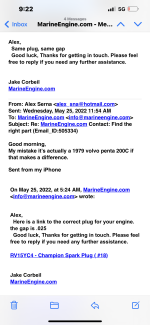OK your engine will run on land with no load on it, but the minute that you put a load on it (even just putting it into gear in the water puts a load on the engine) it dies. This suggests carb/fuel delivery problems. When you rebuilt the carb how did it look inside? Were all the jets blown out, to make sure there were no clogged jets, and same with the air bleeds? Also marine inboard engines have a check valve called an anti siphon valve on the gas tank. These are a safety device that prevents fuel from siphoning out of the tank if the fuel line to the fuel filter/pump leaks. If they get corroded or clogged with debris that same problem can happen. If your points are set right (use the dwell meter) you cap & rotor are good, high tension leads as well (check for resistance against specs) timing is set properly then turn back to the fuel system. Exhaust restrictions can cause trouble too but fuel delivery problems are very common on old boats. Fuel pump, fuel filters, anti siphon, fuel tank vent. All should be checked.
One last thing if that is a points distributor it probably has mechanical advance unit under the point mounting plate. This is a pair of weights that move out under centrifugal force to advance the timing as you increase RPM. There are also springs that pull them back in as the engine slows down. These can be frozen up due to corrosion especially on a boat that sat for years. I have a Prestolite distributor just like that and there is a wick in the distributor shaft that you can see when you remove the rotor. I just put 2 drops of motor oil on that wick each season that is all it takes to keep it working. You may have to remove the point plate to make sure the weights move freely and the springs that retain them aren't broken.
A properly maintained points distributor with mechanical advance is definitely worth keeping as long as you don't mind maintaining it. No electronic mystery boxes to fail, or be un-available. A spare set of points and condenser and you can be back on the water in an hour or less.





















